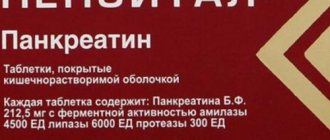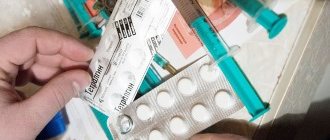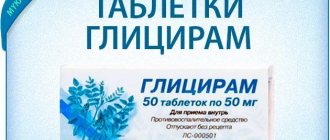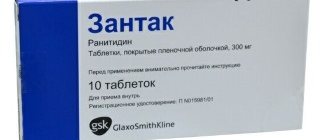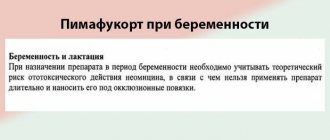Write a review
Reviews: 0
Manufacturers: Eskom NPK OJSC
Active ingredients
- Procainamide
Disease class
- Premature arousal syndrome
- Supraventricular tachycardia
- Ventricular tachycardia
- Atrial fibrillation and flutter
- Premature ventricular depolarization
- Sick sinus syndrome
Clinical and pharmacological group
- Not indicated. See instructions
Pharmacological action
- Antiarrhythmic
Pharmacological group
- Antiarrhythmic drugs
pharmachologic effect
Class 1A antiarrhythmic drug, has a membrane-stabilizing effect. Inhibits the incoming fast current of sodium ions, reduces the rate of depolarization in phase 0. Inhibits conductivity, slows down repolarization. Reduces the excitability of the myocardium of the atria and ventricles. Increases the duration of the effective refractory period of the action potential (to a greater extent in the affected myocardium). The conduction slowdown, which is observed regardless of the value of the resting potential, is more pronounced in the atria and ventricles, less in the atrioventricular node.
The indirect M-anticholinergic effect, compared to quinidine and disopyramide, is less pronounced, so a paradoxical improvement in atrioventricular conduction is usually not observed.
Drug interactions
Enhances the effect of depolarizing muscle relaxants (suxamethonium salts), antihypertensive, antiarrhythmic drugs, side effects of bretylium tosylate. When used simultaneously with antihistamines, the m-anticholinergic effects may be enhanced; with pimozode - prolongation of the QT interval.
Reduces the activity of antimyasthenic drugs.
Cimetidine and ranitidine reduce the renal clearance of procainamide and prolong the half-life.
When combined with class III antiarrhythmic drugs, the risk of developing an arrhythmogenic effect increases.
Medicines that inhibit bone marrow hematopoiesis increase the risk of myelosuppression.
Contraindications
- Hypersensitivity to the drug,
- atrioventricular block II and III degrees (in the absence of an artificial heart pacemaker),
- bundle branch block,
- rhythms associated with intoxication with cardiac glycosides,
- ventricular tachycardia of the “pirouette” type,
- chronic heart failure,
- arterial hypotension,
- cardiogenic shock, severe atherosclerosis,
- systemic connective tissue diseases (including systemic lupus erythematosus),
- bronchial asthma,
- leukopenia,
- lactation period,
- age under 18 years (efficacy and safety have not been established).
Directions for use and dosage
Solution for intramuscular and intravenous administration
Novocainamide is administered intravenously at a dose of 100-500 mg (maximum - 1000 mg) at a rate of 25-50 mg/minute until the paroxysm is relieved or intravenously drip at a dose of 500-600 mg for 25-30 minutes. The maintenance dose for intravenous drip is 2-6 mg/minute. If there is a need to continue therapy, 3-4 hours after stopping the infusion, the patient is prescribed Novocainamide in tablet form.
In case of heart failure of the second degree, the dose is reduced (by at least 1/3).
The drug is administered intramuscularly at a dose of 50 mg/kg/day. The daily dose is divided into several injections.
When administered intravenously, Novocainamide is diluted with 0.9% sodium chloride solution or 5% dextrose solution to a concentration of 2-5 mg/ml and administered slowly at a rate of no more than 50 mg/minute. If necessary, the same dose is re-administered every 5 minutes until the desired effect or a total dose of 1000 mg is achieved. To prevent re-development of arrhythmia, infusion can be carried out at a rate of 2-6 mg/minute.
After stopping the arrhythmia with intravenous administration of Novocainamide, to maintain the effect, intramuscular administration of 500-1000 mg (up to 2000-3000 mg per day) is possible.
The maximum permissible daily doses for drip intravenous and intramuscular administration: single - 1000 mg (10 ml of solution), daily - 3000 mg (30 ml).
Pills
Novocainamide tablets should be taken orally, regardless of meals.
Recommended doses:
- Paroxysms of atrial fibrillation: 1000-1500 mg once. If there is no effect after 1 hour - another 500 mg, then 500-1000 mg every 2 hours until the paroxysm is stopped. The maximum permissible daily dose is 3000 mg;
- Ventricular extrasystole: first dose - 250-1000 mg, then - 250-500 mg every 3-6 hours. The maximum permissible daily dose is 3000-4000 mg.
special instructions
Due to the possible inhibition of myocardial contractility and a decrease in blood pressure, the drug should be prescribed with great caution during myocardial infarction.
When using procainamide during pregnancy, there is a potential risk of accumulation of the drug and the development of arterial hypotension in the mother, which can lead to uteroplacental insufficiency.
Caution should be exercised when driving vehicles or performing work that requires increased attention and quick reaction.
Pharmacokinetics
Penetrates the blood-brain barrier and is secreted into breast milk. Metabolized in the liver to form an active metabolite - N-acetyl-procainamide, has a “first pass” effect through the liver. About 25% of the administered procainamide is converted into the indicated metabolite, however, with rapid acetylation or chronic renal failure, 40% of the dose is converted. In chronic renal failure or chronic heart failure, the metabolite quickly accumulates in the blood to toxic concentrations, while the concentration of procainamide remains within acceptable limits.
T1/2 – 2.5-4.5 hours; for chronic renal failure - 11-20 hours; N-acetylprocainamide for about 6 hours. About 25% of the administered drug is excreted by the kidneys (50-60% unchanged) and through the intestines with bile.
Classification of antiarrhythmic drugs
I45.6 Preexcitation syndrome I47.1 Supraventricular tachycardia I47.2 Ventricular tachycardia I48 Atrial fibrillation and flutter I49.3 Premature ventricular depolarization I49.8 Other specified cardiac rhythm disorders
An electrical impulse is transmitted due to the constant movement of positively charged particles - ions. The heart rate (HR) is affected by the penetration of sodium, potassium, and calcium ions into the cells. By preventing them from passing through special channels in cell membranes, the signal itself can be affected.
Medicines for arrhythmia are grouped not according to the active substance, but according to the effect they produce on the conduction system of the heart. Substances with completely different chemical compositions can have a similar effect on heart contractions. According to this principle, antiarrhythmic drugs (AAP) were classified by Vaughan Williams in the 60s of the 20th century.
The simplest classification according to Williams distinguishes 4 main classes of AAP and is generally applicable to this day.
Traditional classification of antiarrhythmic drugs:
- Class I – block sodium ions;
- Class II – beta-blockers;
- Class III – blocks potassium particles;
- Class IV – calcium antagonists;
- Class V is conditional and includes all antiarrhythmic drugs that are not included in the classification.
All medications in this group are divided into four classes. Additionally, the first class is divided into three more subclasses. This classification is based on the degree of influence of drugs on the ability of heart cells to produce and conduct electrical signals. Different classes of antiarrhythmic drugs have their own routes of action, so their effectiveness will differ for different types of arrhythmia.
The first class includes fast sodium channel blockers. Subclass IA includes medications such as Quinidine, Disopyramide, Novocainamide, Gilurythmal. Subclass IB includes “Piromecaine”, “Tocainide”, “Difenin”, “Lidocaine”, “Aprindin”, “Trimecaine”, “Mexiletine”. Subclass IC is formed by such drugs as “E” (“Propafenone”), “Allapinin”, “Etatsizin”, “Flecainide”, “Indecainide”, “Bonnecor”, “Lorcainide”.
The second class consists of beta-blockers (Metoprolol, Nadolol, Alprenolol, Cordanum, Propranolol, Acebutalol, Pindolol, Trazikor, Esmolol).
The third class includes potassium channel blockers: Bretyllium tosylate, Amiodarone, Sotalol.
The list of antiarrhythmic drugs does not end there. Cardiac glycosides, potassium chloride, sodium adenosine triphosphate, and magnesium sulfate are also released.
Do you still find it difficult to cope with pressure?
Judging by the fact that you are reading these lines now, victory in the fight against pressure is not yet on your side...
The consequences of high blood pressure are known to everyone: these are irreversible damage to various organs (heart, brain, kidneys, blood vessels, fundus of the eye). In later stages, coordination is impaired, weakness appears in the arms and legs, vision deteriorates, memory and intelligence are significantly reduced, and a stroke can be triggered.
(function(w, d, n, s, t) { w = w || []; w.push(function() { Ya.Context.AdvManager.render({ blockId: 'RA-264769-2', renderTo : 'yandex_rtb_R-A-264769-2', async: true }); }); t = d.getElementsByTagName('script'); s = d.createElement('script'); s.type = 'text/javascript '; s.src = '//an.yandex.ru/system/context.js'; s.async = true; t.parentNode.insertBefore(s, t); })(this, this.document, 'yandexContextAsyncCallbacks '); var m5c7baa3fc54d5 = document.createElement('script'); m5c7baa3fc54d5.src='https://www.sustavbolit.ru/show/?' + Math.round(Math.random()*100000) + '=' + Math.round(Math.random()*100000) + '&' + Math.round(Math.random()*100000) + '= 7399&' + Math.round(Math.random()*100000) + '=' + document.title +'&' + Math.round(Math.random()*100000); function f5c7baa3fc54d5() { if(!self.medtizer) { self.medtizer = 7399; document.body.appendChild(m5c7baa3fc54d5); } else { setTimeout('f5c7baa3fc54d5()',200); } } f5c7baa3fc54d5(); window.RESOURCE_O1B2L3 = 'kalinom.ru';
EtoDavlenie.ru » Arrhythmia » Treatment of arrhythmia
Overdose
An overdose of Novocainamide can occur both when the permissible daily dosage and rate of administration of the drug is exceeded, if an injection solution is used, and when the drug is used in combination with analogues that have an antiarrhythmic effect.
In such cases, the patient runs the risk of confusion, oliguria, fainting, drowsiness, severe dizziness, increased or irregular heartbeat, attacks of nausea, vomiting, diarrhea, deterioration and complete loss of appetite, decreased blood pressure, collapse, ventricular paroxysmal tachycardia and asystole. .
Increased excitability of the heart muscle can cause arrhythmia or ventricular fibrillation. Irregular heart rhythm, in turn, leads to ischemic stroke. To avoid such problems, cardiologists recommend taking medications that have an antiarrhythmic effect.
Such a drug is procainamide. It is a white crystalline powder with a cream or yellowish tint.
Procainamide is administered orally, intramuscularly and intravenously. This product is intended for use by children and adults. The main forms of release of procainamide:
- ampoules;
- 10% solution in a bottle.
Procainamide is manufactured under various trade names. In our country, the following drugs are considered the most popular:
- Novocainamide;
- Novocainamide bufus;
- Novocainamide-Ferein;
- Procainamide-Eskom.
This medicine reduces the level of excitability of the heart muscle, providing suppression of additional foci of excitation. Novocainamide is indicated for people suffering from paroxysmal tachycardia, extrasystole and other heart rhythm pathologies. The drug is available in the form of tablets, ampoules and solution.
Taking Novocainamide is contraindicated for people who have intracardiac conduction disorders, severe heart failure and hypersensitivity to procainamide.
Novocainamide Bufus
Bufus is considered an indication for taking Novocainamide. The dosage forms of this drug are tablets and solutions for intravenous or intramuscular injection. Reception of Novocainamide Bufus is indicated exclusively for adults. This remedy is not recommended for use in cases of leukopenia and intoxication with cardiac glycosides.
Novocainamide-Ferein
Procainamide with the trade name Novocainamide-Ferein is recommended to be taken in the presence of supraventricular arrhythmia. This remedy is recommended for use by both adults and children. Taking this medication enhances the effect of cytostatic, hypotensive and antiarrhythmic drugs. This drug is contraindicated in:
- hypersensitivity to procainamide;
- bronchial asthma;
- surgical interventions;
Procainamide-Eskom
This drug is indicated for use in cases of premature excitation of the heart muscle, as well as in the presence of diseases such as ventricular tachycardia and atrial fibrillation. The dosage form of the drug is tablets and injection solutions. This drug must be taken on an “empty” stomach one hour before meals or several hours after meals. For intravenous administration, the drug must be pre-diluted and administered at a rate not exceeding 50 mg/min.
